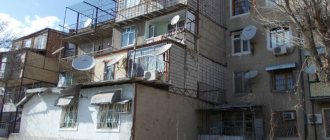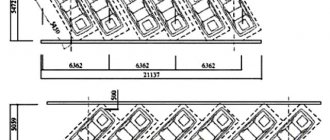Almost every apartment building has basements, which very often become the main point of contention between neighbors. This happens because there are many families in the hallways, but there are not enough additional storage spaces. Most often, each of the residents wants to take possession of the extra square meters and is sometimes ready to go to court for this. So who rightfully owns the technical floor and how to achieve it for personal use? What laws and nuances should you know when fighting with neighbors for “tidbits of space”? And how will you be able to privatize a basement in an apartment building with minimal material costs?
Why do you need a basement in an apartment building?
Many apartment buildings built in Soviet times have technical floors that are designed to ensure the life of the apartments. They contain parts of utilities, such as heating and water supply risers, pipelines, as well as various equipment and structures.
Attention! If you have any questions, you can chat for free with a lawyer at the bottom of the screen or call Moscow; Saint Petersburg; ext.480 Free call for all of Russia.
In addition to the main function, the basements of apartment buildings (MCDs) also perform secondary functions; the premises can be used by residents for household needs:
- a workshop can be organized in the basement, which can be used for commercial activities or used for domestic needs;
- the occupied area can be used as a cellar for storing food, such as: fruit and vegetable supplies for the winter, cappings or cereals;
- on the technical floor various things of residents can be stored: clothes, old furniture or equipment, bicycles, sleds, etc.;
- After receiving permission from the BTI and consent from neighbors, the owners have the right to carry out redevelopment in the basement of an apartment building and make an additional room from part of it, cutting an entrance for it in the floor of the apartment.
Normative base
To get the use of the basement of an apartment building, you should find out who has the right to occupy the technical floor and how to privatize non-residential space correctly, without breaking the law. The regulatory framework will help with this, which includes articles and laws that define the principles and main nuances of the distribution of basement space between residents of an apartment building.
According to Article 36 of the Housing Code, the technical floor is the common property of the owners of a multi-storey building, and residents can own, use and dispose of it. It is worth considering that reducing the basement during the reconstruction process can only be done with the consent of all citizens living in the apartment building.
This article of the Housing Code assumes that, by decision of all owners, premises with permitted common use can be transferred to the full ownership of other persons, if this does not violate the interests and rights of these citizens.
Art. 289 of the Civil Code of the Russian Federation implies that the basement of an apartment building is the joint property of the apartment owners, between whom legal relations regarding the technical floor are determined by the 6th and 9th articles of the Housing Code. Thus, each owner of housing space owns a share of basement premises, but their alienation is limited by Article 290 of the Civil Code of the Russian Federation, and use by 288.
Citizens must comply with Art. 30 LC duties and know that they have the right to create property partnerships in accordance with Article 291 of the Civil Code of the Russian Federation.
| № | Article | Name |
| 1 | 36 Residential Complex of the Russian Federation | Ownership rights to common property of premises owners in an apartment building |
Who owns the basement in the house?
Often, residents of a house cannot determine who owns the basement in the house. Neighbors should take into account that premises with prohibited private access (the area on which utility networks, communications, water supply, heating, etc. are located) cannot be transferred into private ownership. But the rest of the technical floor can be used by citizens with the right property at your own discretion. According to the Housing Code of the Russian Federation, in privatized apartment buildings the owners (common shares) of basement premises are the residents: the first part of Article 37 of the Housing Code of the Russian Federation states that they have the right to such a share of the joint property that is proportional to the size of the apartment belonging to the owner. But for this the following conditions must be met:
- the basements of an apartment building should not be owned at the time of privatization of housing;
- the technical floor should not have any specific purpose;
- the basement must be separated from the apartments of a multi-story building.
Also an important condition for the owners to own non-residential premises in equal shares is the presence of technical equipment in it, with the help of which more than one apartment is serviced.
It should be taken into account that if all the apartments of a multi-storey building belong to the city, then the technical floor premises cannot have an owner, and the basement should be used only as a technical room for utilities.
The decisive factor in determining the right to this property is the question of whether the house is under the control of the TSC and whether it is part of the HOA, since in this case the common premises of the house will necessarily belong to management companies.
Read more: How to pay an administrative fine for a director
To determine who owns the basement in a high-rise building, you should contact Rosreestr for an extract: it will indicate not only the real owner of the premises, but also must specify the date when he became the owner of this area and the reasons due to which the technical floor was privatized by this person . This can be done using the official website of Rosreestr (public cadastral map).
How to protect your home from water
To do this, make blind areas with a slope from the walls of the house to the outside.
The blind areas are made from ninety to one hundred centimeters wide, then you need to look at what level the blind areas are in relation to the threshold. The threshold should be 6-8 centimeters above the edge of the blind area.
If this condition is not met, the threshold must be raised to the required height. To do this, the door is dismantled, its opening in the upper part is enlarged, and bricks are laid out in the lower part. At the same time, we must not forget about waterproofing.
And having completed all the work to protect the basement from water, you need to decide where to divert it.
Next, we will equip the roof drainage system with a slope in the direction where the storm drainage system will be installed. To prevent storm drains from clogging, special grates are placed on the gutters.
Protecting the yard from melt water
Of course, there is a solution; you can equip a container at the lowest point of the storm drain where water will be collected.
To prevent rain and melt water from stagnating on your site, you just need to lay pipes along its path, but it is only important to maintain a slope towards the water collection tank. And make the correct calculation of the number of pipes to drain all the water from the site.
To avoid blockages, install special nets.
There is another problem, water that gets from the street into the yard. What should we do with it? After all, the container you have is not enough to collect it.
Read more: Application to a notary office for acceptance of inheritance
There is a solution! It is necessary to build a ten-centimeter fence along the site. To build such a fence, you must first dig a trench. Then we cover the bottom of the trench with roofing felt, so that one edge remains outside. Next, this trench is concreted to ground level, as a result we get a small foundation with waterproofing. The next step will be laying bricks on the resulting foundation, after which all cracks and cracks are putty on the resulting wall. The last step will be gluing the edge of the roofing material remaining on the surface onto the brick. After all the manipulations, the wall for draining water from the street is ready.
If there is a very large space behind your fence (a field, for example), then retreat fifty or sixty centimeters from the wall and dig a trench (drainage) whose depth should be from twenty to thirty centimeters. Next, this trench is covered with stone, crushed stone or pebbles.
Basements can also be flooded by groundwater, even if you did everything right outside.
Very often, houses are built on a brick foundation, and even with proper treatment, the basement walls become damp. What needs to be done to avoid this problem?
First, it is necessary to carry out standing ventilation; if this does not work, then this means that groundwater is passing nearby. At the beginning, it is worth figuring out what material the foundation is built from, and from this we will proceed on what to do next.
If the basement walls are made of concrete, they must be treated with special penetrating waterproofing. When processing, you need to do everything strictly according to the instructions. Before applying the mixture, the surface must be moistened. After treatment with penetrating waterproofing, the leak may be partially eliminated, but this is not a reason to worry. After all, the crystals that are supposed to seal the leak take a very long time to grow.
This method is suitable for concrete walls, but which one is suitable for brick basement walls?
Let's look further. And so, in order to eliminate the wetting of brick walls, it is necessary to dig a trench (depth 1.5 - 1.8) around the perimeter of the building and pour clay into it.
But if the house is flooded with water, then take action immediately. Namely, all the water from the premises must be pumped out, and then the premises and objects from them must be thoroughly dried and treated with special compounds.
Well, in this article we told you about a method of combating basement flooding in a private house. We hope you find this information useful. We wish you patience and good luck!
Almost any kind of commercial activity requires a salon, office, warehouse, store. Prices and rent for non-residential square meters are high, and a basement is a good alternative to the classic options for running your own business in business centers and apartment buildings. One of the specific problems of business at the underground level is basement flooding.
The content of the article:
If there is a store in a residential building
In life, there are often cases when the entire first floor of an apartment building is occupied by a grocery or household store, cafe, restaurant, billiards, gym, etc. In this case, the basement can be either owned by a commercial organization that uses the technical premises as a warehouse, or and residents. In the first option, the organization is obliged to provide access to utility equipment (immediately in case of an emergency or accident and the next day after written notification during a routine inspection of the condition of the equipment) located in the basement, since they belong to an area with prohibited general access.
Sometimes a commercial organization can be located directly on the technical floor, in this case (for this the consent of the residents of the apartment building must be provided) it must be the owner of the entire occupied territory or a tenant (this area can be rented out only with the consent of all apartment owners).
There are cases when illegal seizure of basement premises occurs, on the territory of which unauthorized shops are opened - going to court will help to cope with this offense.
Is it possible to privatize a basement in an apartment building?
Residents have the right to privatize basement premises in an apartment building if:
- they are apartment owners;
- the technical floor is not owned by anyone;
- basements do not belong to management companies or the municipality.
Citizens privatize the basement in order to:
- use it for personal purposes;
- increase the potential value of an apartment belonging to a given technical floor;
- to seize the premises from the persons who illegally seized it;
- receive your own benefit (renting, etc.).
What is included in the common property of an apartment building and features of its renovation
In accordance with Article 36 of the Housing Code of the Russian Federation, common property in MKD means:
- Premises that are not parts of apartments and are intended to serve more than one room in the house (for example, an elevator, staircases, inter-apartment landings, shafts, basements, attics).
- The plot of land on which the house is located, with elements of landscaping and landscaping.
- Premises that do not belong to any of the owners and are intended for social and cultural leisure of residents.
- Roof , load-bearing and non-load-bearing structures of the building.
- Mechanical, engineering, plumbing equipment that serves more than one room.
Apartment owners can dispose of common property only jointly . They do not have the right to sell their share or dispose of it in any other way separately from the apartment - a share of the common property can pass to another owner only together with the housing. In accordance with clause 1. 158 of the Housing Code of the Russian Federation, owners in apartment buildings bear the costs of maintaining their housing by paying a fee :
- for maintenance and current repairs;
- for major repairs.
Current repairs include work to maintain the apartment building in a favorable condition . For example, replacing glazing in the entrance, repairing stairs and railings, carrying out cosmetic repairs, and eliminating minor faults. Unlike major repairs, fewer requirements are established for current repairs, they are less expensive and require less time to carry out.
Work related to improving the condition of the building, as well as replacing and reinstalling its worn parts, is included in the list of expenses for major repairs.
Every month, apartment owners in apartment buildings are required to pay the costs of major repairs. The amount of the fee is established by the regulatory act of the constituent entity of the Russian Federation and depends on the technical characteristics of the building, as well as on the square area of the housing (Article 169 of the Housing Code of the Russian Federation).
Technical regulations for the overhaul of the roof of an apartment building
The overhaul of the roof of an apartment building includes the following work:
- for the complete restoration of all properties of the roofing (hydro-, noise- and thermal insulation);
- repair of the drainage system, joints of floor slabs, as well as the junction of the roof with the eaves;
- restoration of ventilation shafts and wooden structures.
During the overhaul process, outdated materials are replaced with modern ones in order to extend further operation. Work is carried out once every 10-50 years , depending on the type of roof, provided that more than 40% of the coating . The timing of the work and its cost significantly exceed the costs of partial repairs.
Coordination of repair work is carried out by the management company; engineering specialists accept the work and conduct technical supervision over the progress of its implementation. After completing a major roof repair, the company that carried out the work issues a warranty document , which indicates the service life of the repaired roof.
Major renovation of the facade of an apartment building
The list of works for major repairs of the facade of an apartment building includes:
- Sealing cracks and eliminating leaks.
- Removing old coating, insulating walls and sealing joints.
- Cleaning from rust and fungal deposits.
- Applying plaster, laying tiles, stone.
- Replacement of drainpipes.
The work is aimed at completely restoring the facade, giving the house a new look. Major repairs are carried out once every 10 years , subject to the presence of the following defects:
- more than 30% was damaged ;
- The seams collapsed, the insulation layer completely crumbled;
- deformation of the gutters causes moisture to enter the walls.
The degree of destruction of the facade is determined by a special commission, which consists of an initiative group of residents and representatives of the regional operator. For each type of facade, a technological map with a list of building materials, as well as technology for performing repair work.
When carrying out major repairs of the facade:
- Leaks and malfunctions are eliminated, engineering structures are restored or replaced.
- Innovations and more efficient repair technologies are used.
- Safe, non-flammable materials are used.
Overhaul of the foundation of an apartment building
Major repairs of the foundation of an apartment building include the following list of works:
- strengthening the foundation, screed along the contour;
- updating the drainage system;
- cementation of cracks;
- elimination of local defects and deformations;
- repair of glued and coated foundation insulation;
- removal of destroyed layers;
- creating waterproofing.
Repair work consists of strengthening the foundation of the house, completely reconstructing the facade, and replacing damaged parts. Overhaul of the foundation is a technically complex task; the management company must regularly carry out cosmetic repairs of the foundation for preventive purposes every 5-10 years .
Replacement of elevators under the overhaul program
Replacement of elevator equipment is carried out as part of a major overhaul if a decision has been made to declare it unfit for use (clause 2, clause 3, article 15 of Federal Law No. 185 of July 21, 2007). Before the start of work, a technical examination is carried out, as a result of which the operability of the elevator is determined. Based on the results of the inspection, specialists prepare an expert report , which contains a list of all malfunctions of elevator equipment and shafts.
First of all, elevators whose service life has exceeded 25 years . Before the start of work, the management company must notify residents about the replacement of the elevator 6 months in advance . If there are several elevators in a building, replacement of equipment should be carried out in order of priority. Depending on the number of floors of the apartment building, replacement lasts up to 2 months .
Major renovation of the basement and basements
The list of works for the overhaul of the basement and basements includes:
- Insulation of walls and basement floors.
- Floor repair.
- Installation of metal doors in basements.
- Repair of utility networks in external walls.
- Waterproofing walls and floors.
- Replacing the drainage system.
- Restoration of the blind area.
- Repair of vents and basement windows.
The scope of work for basement repairs may change at the design stage and coordination of the scope of work carried out with the owners. Owners of basements allocated for pharmacies, cafes, shops, etc., are obliged, along with other residents of the house , to bear the costs of maintaining common property, since basements are a constructive part of the apartment building.
How to privatize a basement in a residential building?
The most difficult thing in the procedure for privatizing the basement of an apartment building is obtaining the consent of all owners of the apartment building.
- To begin with, a general meeting of residents should be held, the topics of which will be the transformation of the boundaries of the technical floor and the alienation of part of the joint property. To do this, you need to draw up a protocol that will comply with Articles 36, 44-46 of the Housing Code, as well as notify the apartment owners about the upcoming event 10 days in advance. At least half of the owners must be present and more than fifty percent of consents, confirmed by the signatures of those present, must be obtained.
- After a successfully held meeting, it is required to draw up petitions from persons who will be the future owners of the basement and make certified copies of documents for housing in this apartment building. You also need to have a plan for that part of the technical floor that will be privatized, and contact the Housing Office to obtain a building inspection report.
- The next point will be the signing of a contract with a design organization that can help in preparing the reconstruction of the basement of an apartment building: a conclusion must be made confirming the intention of the new owner not to violate the operating system of the residential building. After completing the described actions, you should submit documents with an application to the interdepartmental commission related to the district administration.
- In order to privatize a technical floor, the future owner must obtain permission from the Architecture Department, as well as coordinate the reconstruction project with the SES and the fire organization.
- The basement cannot be transferred into ownership if housing and communal services bills are not paid before the submission period. Therefore, after eliminating the debts, you need to file a claim in court, attaching all the required documents and permits.
- Upon successful completion of the trial, ready permits should be obtained from the interdepartmental commission and the Department of Architecture.
- The last stage in the privatization of the basement of an apartment building is the registration of title documents at the BTI and the receipt of a cadastral plan, after which it will be possible to carry out an inventory of the premises. Now all that remains is to carry out the required work in the basement and put it into operation.
Where to file a complaint
The drawn up flooding report must be kept by the injured party until compensation for the damage caused to it. If, after the inspection, the decision of the expert commission and the drawn up inspection report, the management company does not take any action to resolve the situation and eliminate the causes and consequences of the flood, complaints should be filed against the housing and communal services or management company to higher authorities:
- The State Housing Inspectorate, which will inspect the activities of the management company.
- Rospotrebnadzor is an organization that protects consumer rights.
- The prosecutor's office, if the situation requires judicial intervention in order to identify and punish the perpetrators.
Flooding of a house and basement is an unpleasant situation that requires action primarily from the interested party, that is, the residents themselves. Company managers very rarely solve such problems independently and in a timely manner.
Read more: They call and offer free legal advice
Even if the management company admitted their own guilt in the incident, an additional, independent examination should be carried out to assess the causes and consequences of the accident. In a situation where the property located in a flooded basement was insured, but the required insurance does not cover the damage caused, it is necessary to go to court to recover the missing amount from the person responsible for the incident.
Water in the basement of an apartment building, how to deal with this problem?
The basement for an apartment building is very important than it might seem at first glance. Almost all communications serving the house are collected here, affecting the normal functioning of all systems, such as general house communications for cold and hot water supply, sewerage. Shut-off valves are installed to shut off the water; often water supply meters, common to the entire house, are installed in the basement. The basement plays a very significant and large role for all residents, and accordingly, the problems it causes are significant and large. The basement can flood with cold or hot water from a broken pipe. The sewer can fill it up. An error in the design of a house can cause groundwater to constantly rise, gradually destroying the foundation. All this threatens not only an unpleasant odor and mold in apartments. The biggest danger is that if the foundation is destroyed, the house can collapse, threatening the lives of its occupants. It often happens that a management company, for the sake of extra income, rents out basement premises to some entrepreneurs. And then access to all communications becomes difficult or impossible. Utility workers are in no hurry to solve all this multitude of problems, constantly coming up with some excuses. One example:
And these are complaints about sewerage going directly to the basement:
And in this video, utility workers blame groundwater for everything, but residents have a different opinion:
Basement problems are everywhere, just like management companies. Somewhere they are larger, somewhere a little smaller, but in an apartment building they sometimes become critical and pose a threat to the safety of the entire building.
When a pipe breaks, water appears, or a smell appears in the basement, we start calling the housing and communal services, hoping for a quick solution. Often utility companies offer to pay for repairs separately. But this is not correct, since the basement is a common property of the house, and we already pay for its maintenance in payment receipts every month. The management company is obliged to investigate and repair all damage and pump out water at its own expense. It happens that housing and communal services employees themselves, when changing someone’s pipes or carrying out their work, drain water into the basement. In any case, you need to call the dispatcher and write a complaint to your own, approved by Resolution of the State Construction Committee of the Russian Federation dated September 27, 2003 No. 170. They, in particular, say that basements must be clean and dry, have ventilation and lighting. Flooding due to leaks from faulty equipment should not be allowed. The responsibilities of the management company to carry out work, routine repairs and services for the maintenance of common property are clearly stated in Decree of the Government of the Russian Federation of August 13, 2006 No. 491. If all your statements about water in the basement, stench emanating from it or faulty shut-off valves have not received any response from housing and communal services workers, contact Rospotrebnadzor, and if, in your opinion, all this also threatens the health of the residents, you can involve more and "SanPiN". The latter also have their own law on standards for the operation of residential buildings: 2.1.2.2645-10. By the way, there is a clause prohibiting the use of premises not provided for in the design documentation. This applies to utility companies trying to make money on basement premises by renting them out. In any case, these organizations must send their commissions and inspect everything on site to make a decision. There is a possibility that utility workers will try to eliminate the faults before the commissions appear, but so that the commissions do not consider that residents are groundlessly blaming housing and communal services workers, you can prepare photo and video evidence of all discrepancies. If all of this caused damage to your property, or, even worse, harm to your health, write to the prosecutor’s office. File a claim in court for compensation for moral and material damage.
Utilities are required to monitor the correct and uninterrupted operation of the common property of houses and all house systems. Respond to all citizen complaints, eliminate malfunctions and breakdowns. But residents must also comply with all the rules and regulations for using the systems, in particular, not to clog the sewer with various garbage that is not intended for it. Promptly inform utility workers about pipe ruptures and other malfunctions that may impair the proper operation of the house. Do not try to repair housing and communal services property yourself; it is best to call specialists through the dispatcher who will carry out all the work at the proper level.
The basement in a private house is flooded: where to go and what to do? Instructions + Photos and Videos.
For the construction of private houses, as a rule, they choose lightweight and high-quality materials that can retain heat well in the house, as well as aesthetically attractive materials for exterior decoration, etc. These materials are good if the house is not located near a pond and is not in a lowland. It happens that houses located near the water or in lowlands are flooded. What needs to be done to prevent the basement of the house from flooding? Let's talk about this further.
Let’s look further at what needs to be done and what materials will be needed.
Redevelopment in the basement
By planning a privatized basement, you can increase the living space, create an additional place for relaxation or entertainment, and also organize a convenient warehouse for storing things that are not used in everyday life.
If there are still controversial issues, you can also consult a free chat with a lawyer at the bottom of the screen or call Moscow; Saint Petersburg; ext.480 Free call for all of Russia.
To bring this idea to life you will need:
- prepare a floor plan with an explanation;
- make a copy of your personal account;
- obtain an extract from the house register, which must indicate all the persons registered in the apartment of the multi-storey building;
- have a notary certify a copy of documents confirming ownership;
- develop a basement redevelopment project.
The following difficulties may arise during this procedure:
- It may not be possible to design a living space from the basement of an apartment building if the Utilities refuse to give permission for this type of redevelopment due to non-compliance with sanitary standards requiring the presence of at least one light source in the room;
- It is possible that difficulties will arise when redeveloping a technical floor into an office or store, since this requires a complex procedure for registering an apartment as a non-residential premises;
- Restrictions may arise when processing redevelopment due to the poor condition of the multi-storey building and the long-term lack of major repairs.
Spontaneous seizure of the basement
Often there is an illegal seizure of the basement of an apartment building. Most often, the reason for such offenses lies in the fact that the owners do not know that they are the owners of the technical floor, and also because of the instability in the country in the 90s. The problem is that “fake” owners stubbornly prove their rights to the technical floor, arguing that they have invested material resources for major repairs and redevelopment. But these arguments have no legal force, so residents of a multi-storey building can safely defend their rights.
Read more: How to complain about a lawyer to the Bar Association
Filing a lawsuit in court will help restore justice in this case.
What to do if a basement used for commercial purposes is flooded - step-by-step instructions
After detecting a flood in the room, it is recommended to take the following actions:
- Turn off electricity in the room to prevent short circuits.
- Find out the cause of the flooding.
- Eliminate the cause of the flood. If you cannot do this yourself, call emergency services.
- Collect evidence of the incident: record flooding and damage to property using a camera, phone, or video camera. At this stage, you can invite the person responsible for the incident to verify that the damage was caused.
- Eliminate consequences.
- Call the employees of the Management Company to draw up a flood report.
Even if the guilty party has agreed to compensate for the damage caused by the flood, you should not neglect the collection of material evidence. In the future, refusal to pay expenses or disagreement with the amount of compensation payment is possible.
Drawing up a flood report
The flood report is drawn up by a commission, which includes:
- The owner or representative of the owner of a flooded commercial premises.
- The person at fault or his representative (if the cause of the flooding has been established).
- An employee of the building maintenance organization.
Other persons may be included in the commission. It is better to ask neighbors or witnesses to the incident, who can then speak in court. It is advisable to invite the chairman or chief engineer from the housing department or management company.
The form of the flood report has not been established.
The document can be written by hand on a regular blank sheet of paper. But representatives of the management organization usually already have a standard printed form that can be quickly filled out on the spot.
Read more: What official temporary registration looks like in Moscow
Contents of the flood report
The flood report contains the following information:
- Date of examination.
- Date of occupancy of the premises.
- Composition of the commission.
- Address of the property being surveyed.
- Fact and cause of flooding.
- List of damaged property, extent of damage.
- Cause-and-effect relationship between flooding and damage caused.
All members of the commission sign the document, and the seal of the service organization is affixed. If one of those present refuses to sign, this fact is reflected in the flooding report.
Attention! To determine the amount of damage received, you should additionally obtain a report from an appraisal company. The services are paid, but without this document it is impossible to justify the amount of claims in court.
The video story will tell you about the intricacies of writing the act of flooding the premises









